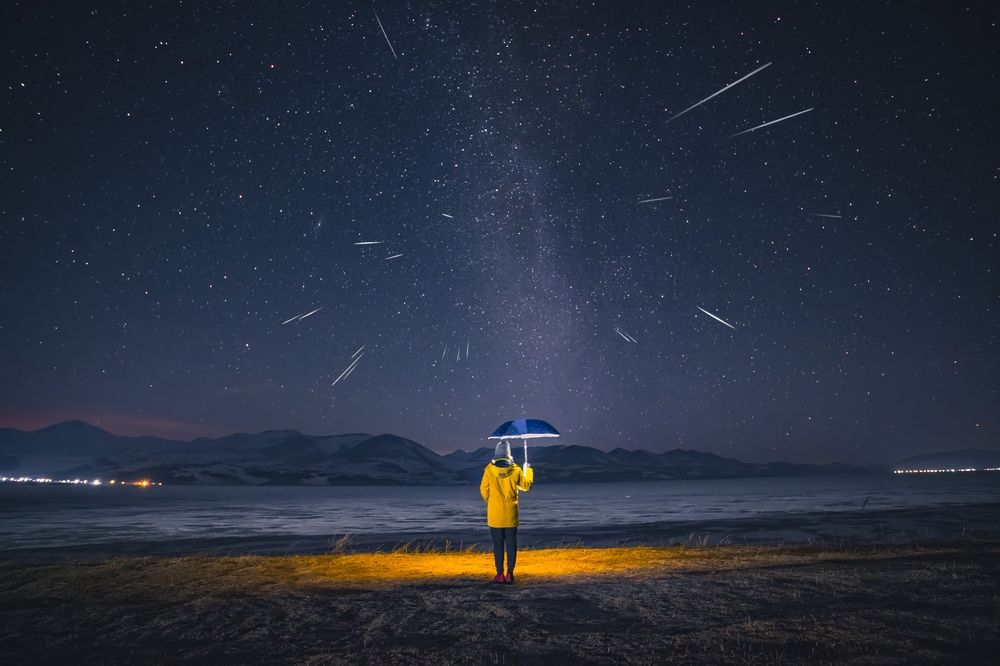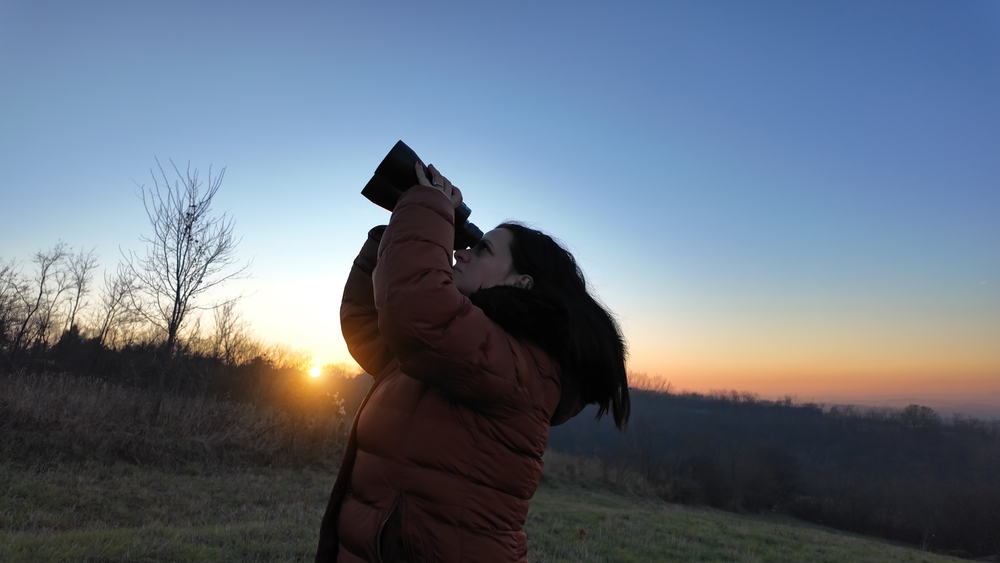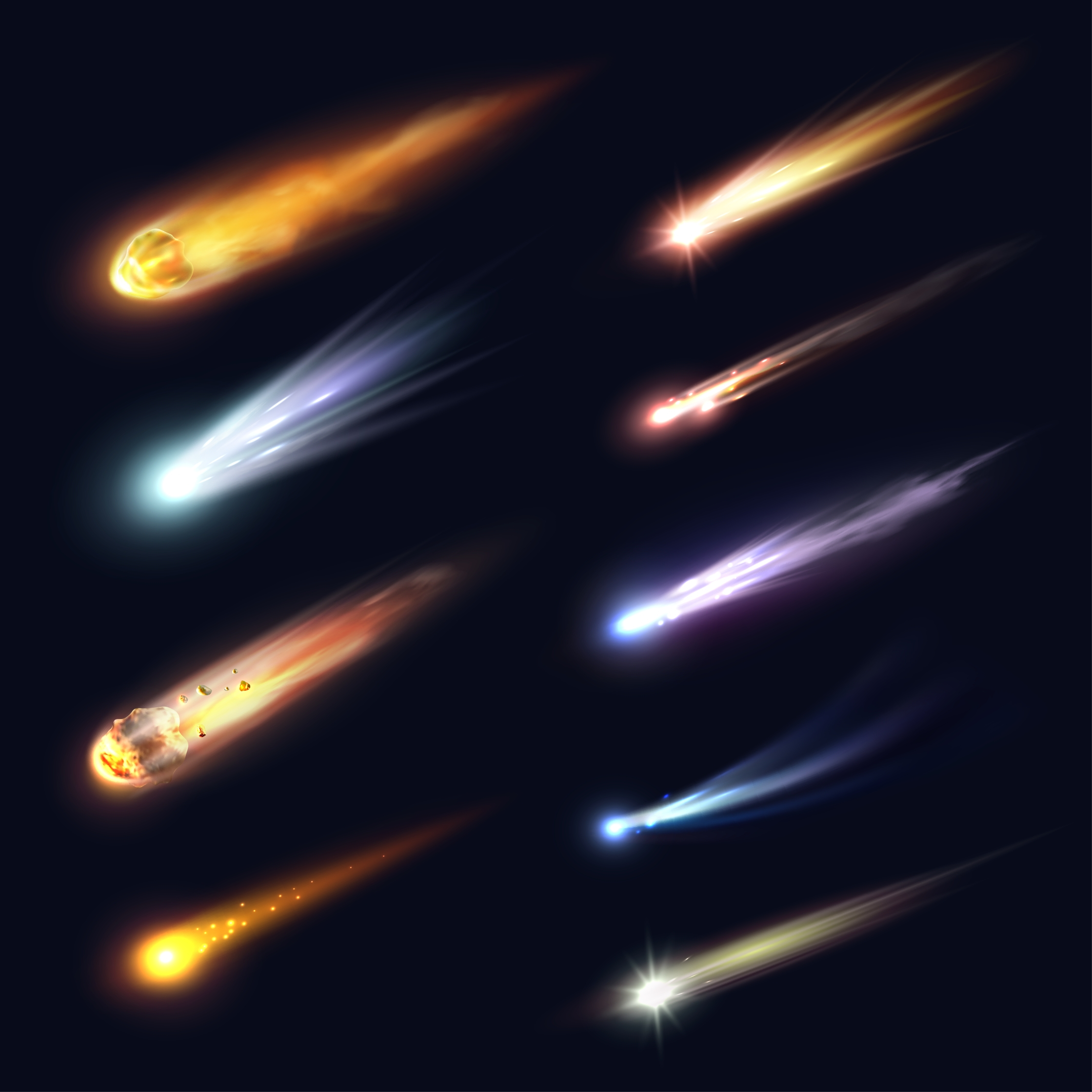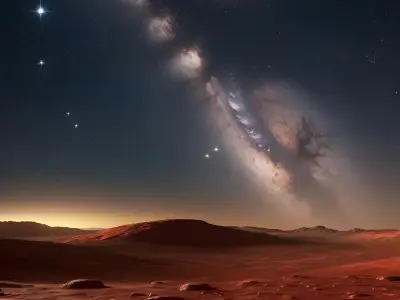Meteor showers are celestial events that can be observed worldwide. Whether you’ve seen one before or are planning to catch a glimpse, understanding what meteor showers are and how they occur can make the experience even more enjoyable.
Jump to:
- What Is a Meteor Shower?
- What Causes Meteor Showers?
- The Science Behind Meteor Showers
- What Does a Meteor Shower Look Like?
- The Difference Between Meteors, Meteorites, and Meteoroids
- Meteor Showers in Ancient Myths
- How to See a Meteor Shower
- The Best Time to See a Meteor Shower
- Where to Look for Meteor Showers
- Famous Meteor Showers to Watch
- Frequently Asked Questions About Meteor Showers
- Study Astronomy for £29
What Is a Meteor Shower?
A meteor shower occurs when numerous meteors—commonly known as shooting stars—appear to radiate from a specific point in the night sky. These predictable events occur at certain times of the year when Earth passes through the trail of debris left by comets or, occasionally, asteroids.
Recommended for you!
Best SellersWhat Causes Meteor Showers?
Meteor showers are caused by streams of cosmic debris entering Earth’s atmosphere at high speeds. This debris, often left behind by comets, burns up upon entry, creating bright streaks of light. The radiant point, where the meteors seem to originate, is named after the constellation in that part of the sky.
The Science Behind Meteor Showers
Meteor showers occur when Earth intersects with a comet's orbital path. Comets are icy bodies that release gas and dust as they approach the sun. This debris trail remains in space, and when Earth passes through it, the particles enter our atmosphere and burn up, creating meteors.
What Does a Meteor Shower Look Like?

During a meteor shower, you might see dozens of meteors per hour. They can appear as bright streaks of light zooming across the sky, sometimes leaving trails that last for a few seconds. The intensity and frequency can vary, but on a good night, it's a spectacular sight.
The Difference Between Meteors, Meteorites, and Meteoroids
Understanding the terminology used in astronomy can enhance your appreciation of meteor showers. Three key terms—meteoroid, meteor, and meteorite—describe different stages of these cosmic particles.
- Meteoroid: A meteoroid is a small particle from a comet or asteroid that orbits the sun. These particles vary in size, from tiny grains of dust to larger chunks of rock. They travel through space and can become part of a meteor shower if they intersect with Earth’s path.
- Meteor: When a meteoroid enters Earth's atmosphere and vaporises, it becomes a meteor. This is what we often refer to as a shooting star. The intense heat generated by friction with the atmosphere causes the meteoroid to glow brightly and produce a streak of light in the sky.
- Meteorite: If a meteor survives its fiery journey through the atmosphere and lands on Earth, it is called a meteorite. These remnants can range from small pebbles to large masses of metal and rock. Meteorites provide valuable scientific information about the composition of other celestial bodies in our solar system.
Meteor Showers in Ancient Myths
Meteor showers have inspired many myths and legends across various cultures. In ancient Greece, meteors were thought to be messages from the gods or omens of significant events. The famous Perseid meteor shower, for example, is linked to the myth of Perseus, the hero who beheaded Medusa and saved Andromeda. The meteors were believed to be the tears of Perseus, falling to Earth in sorrow.
In Chinese mythology, meteors were sometimes seen as dragons descending from the heavens. The annual Lyrid meteor shower is connected to the legend of the dragon that grants wishes to those who see its celestial dance. Similarly, in Native American lore, some tribes viewed meteor showers as the spirits of their ancestors visiting from the sky. These celestial events were often incorporated into cultural rituals and storytelling, highlighting their significance and the awe they inspired throughout human history.
How to See a Meteor Shower
Follow these tips to maximise your meteor shower viewing experience and ensure you have the best chance of witnessing this awe-inspiring phenomenon.
- Find a Dark Location: Light pollution from cities and towns can significantly obscure your view of the night sky. For the best experience, head to a rural area or a dark-sky park where artificial light is minimal. Locations like national parks, countryside fields, or designated stargazing spots are ideal. The darker your surroundings, the more meteors you’ll be able to see.
- Look Up and Be Patient: Patience is key when it comes to meteor watching. Once you find a suitable spot, give your eyes about 20 minutes to adjust to the darkness. This process, known as dark adaptation, will help you see faint meteors more clearly. Avoid looking at your phone or any other bright light sources during this time, as it can reset your night vision.
- Check the Weather: Clear skies are essential for a good view of meteor showers. Before heading out, check the weather forecast for your chosen location. Clouds, fog, or rain can obstruct your view and make it difficult to see any meteors. If the weather doesn’t cooperate, consider having a backup date or location in mind.
- Know the Peak Times: Meteor showers have specific peak times when the most meteors are visible. Research the peak times for the shower you’re interested in to plan your viewing accordingly. Peak times often occur in the pre-dawn hours, when the sky is at its darkest and your location on Earth is facing the incoming meteor stream head-on.
- Comfort and Equipment: Bring along a reclining chair or a blanket so you can comfortably look up at the sky for extended periods. Dress warmly, especially if you’re watching in colder months, and consider bringing snacks and drinks. While you don’t need any special equipment to see meteors, binoculars or a telescope can enhance your overall stargazing experience, even if they aren’t necessary for meteor watching.
- Avoid Light Pollution Sources: Even in rural areas, avoid nearby light sources such as street lamps or car headlights. These can diminish your night vision and make it harder to see fainter meteors. If you can, choose a location where you can face away from any nearby lights.
- Stay Safe and Legal: Make sure the area you choose is safe and legal to access at night. Check if any permits are required, especially in national parks or private properties. Bring a flashlight with a red filter to preserve your night vision while navigating to and from your viewing spot.
The Best Time to See a Meteor Shower

Timing is key when it comes to observing meteor showers. The best time is typically during the peak of the shower, which is when Earth passes through the densest part of the debris stream. Late night to early morning hours usually offer the best views. Specific times can vary depending on the shower and your location.
When to See Meteor Showers in the UK
The UK is fortunate to have several opportunities throughout the year to observe meteor showers. Some of the major ones include:
- Quadrantids (January): Known for bright fireballs.
- Perseids (August): One of the most popular, with a high rate of meteors.
- Geminids (December): Offers a fantastic display of bright meteors.
Where to Look for Meteor Showers
Knowing where to look can significantly enhance your meteor-watching experience. Proper planning and understanding of the best viewing locations can make all the difference in catching a spectacular show.
Radiant Point
The meteors will appear to radiate from a specific constellation in the sky. This point is known as the radiant. For example, the Perseids radiate from the constellation Perseus. Identifying the radiant point helps in knowing the general area of the sky to focus on, but it’s important to remember that meteors can appear anywhere in the sky, not just from the radiant.
Wide View
To maximise your chances of seeing meteors, it’s best to have a wide, unobstructed view of the sky. Avoid areas with tall buildings, trees, or mountains that can block parts of the sky. Lying down on a blanket or reclining in a chair can help you take in as much of the sky as possible.
Dark Locations
Light pollution from city lights can significantly diminish the visibility of meteor showers. The darker the sky, the more meteors you’ll be able to see. Head to rural areas, national parks, or designated dark-sky reserves for the best viewing experience. Some of the top dark-sky locations around the world include:
- Exmoor National Park, UK: Known for its exceptionally dark skies, Exmoor offers a fantastic spot for meteor watching with minimal light pollution.
- Northumberland National Park, UK: Another excellent location, Northumberland provides a peaceful and dark environment perfect for stargazing.
- Brecon Beacons, Wales: This park is a designated International Dark Sky Reserve, making it an ideal spot for meteor showers.
- Cherry Springs State Park, USA: Located in Pennsylvania, this park is famous for its dark skies and is a popular spot for stargazing enthusiasts.
- Aoraki Mackenzie, New Zealand: Known as one of the darkest places in the world, this reserve offers spectacular views of meteor showers.
- NamibRand Nature Reserve, Namibia: With virtually no light pollution, this reserve provides some of the clearest night skies for meteor watching.
Optimal Viewing Times
Meteor showers are best viewed in the pre-dawn hours when the sky is darkest. Checking the peak times for the specific meteor shower you wish to observe will ensure you catch the most meteors.
Can You See a Meteor Shower Without a Telescope?
One of the best things about meteor showers is that you don’t need any special equipment. Just your eyes, a comfortable spot, and some patience.
Famous Meteor Showers to Watch

Some meteor showers offer impressive displays and make for captivating viewing. Here are some of the most notable meteor showers to mark on your calendar:
Perseids
Active in August, the Perseids are one of the most popular meteor showers due to their bright and numerous meteors. They are often visible even in areas with moderate light pollution and can produce up to 60-100 meteors per hour at their peak.
Leonids
Peaking in November, the Leonids are famous for their historical meteor storms, where thousands of meteors per hour were observed. While these storms are rare, the Leonids still offer a reliable and beautiful display with about 15 meteors per hour during peak times.
Geminids
In December, the Geminids provide one of the most reliable and spectacular meteor shows. Known for their bright, slow-moving meteors, they can produce up to 120 meteors per hour at their peak. The Geminids are unique as they originate from an asteroid, 3200 Phaethon, rather than a comet.
Quadrantids
Occurring in early January, the Quadrantids are known for their bright fireballs and can produce up to 120 meteors per hour at their peak. However, the peak activity period is short, lasting only a few hours.
Lyrids
Peaking in late April, the Lyrids are one of the oldest known meteor showers, with records dating back over 2,600 years. They typically produce about 20 meteors per hour and are known for their occasional bright meteors and fast-moving trails.
Eta Aquariids
Active in early May, the Eta Aquariids are remnants of Halley's Comet and are best viewed from the Southern Hemisphere. They can produce up to 30 meteors per hour at their peak and are known for their fast and bright meteors.
Orionids
Peaking in late October, the Orionids are also associated with Halley's Comet. They can produce up to 20 meteors per hour and are known for their fast meteors and occasional bright fireballs.
Delta Aquariids
Active from late July to early August, the Delta Aquariids are best viewed from the Southern Hemisphere. They produce about 20 meteors per hour at their peak and are known for their faint but steady stream of meteors.
Recommended for you!
Best SellersFrequently Asked Questions About Meteor Showers
Is a Shooting Star a Meteor?
What we commonly call a shooting star is actually a meteor—a small piece of debris from space burning up in Earth’s atmosphere.
What Do Meteors Look Like in the Sky?
Meteors appear as bright streaks of light darting across the sky. They can vary in brightness and length, with some even creating bursts of light known as fireballs.
Which is The Most Famous Meteor?
The Hoba Meteorite in Namibia is one of the most famous and largest meteorites ever found, weighing around 60 tonnes.
Are Meteor Showers Lucky?
Many cultures consider seeing a shooting star lucky. Meteor showers have inspired numerous myths and legends throughout history, often seen as omens or messages from the gods.
How Long Does a Meteor Shower Last?
While the peak of a meteor shower might last a few hours to a couple of days, the entire period when meteors are visible can extend over several weeks.
Do Meteors Always Have Tails?
Not always. While many meteors leave a glowing trail, especially bright ones, not all do. The tail is a result of the meteor burning up and ionising the air.
What Is the Difference Between a Meteor Storm and a Meteor Shower?
A meteor storm is a more intense version of a meteor shower, with thousands of meteors per hour. These are rare and spectacular events.
Can a Meteor Shower Hit Earth?
Meteor showers themselves don’t hit Earth, as the meteors burn up in the atmosphere. However, occasionally, larger meteors or meteorites might make it to the ground.
Study Astronomy for £29
If you’re fascinated by meteor showers and want to learn more about astronomy, consider the Astronomy Diploma Course offered by Centre of Excellence. For a limited time, you can enrol for just £29.













